From streaming giants to global e-commerce leaders, million-euro brands have ditched rigid CMS templates for lightning-fast TYPO3 headless stacks. Why? Because publishing once and delivering everywhere, web, mobile, and wearables, unlocks revenue, agility, and future-proof freedom. Ready to see how decoupled TYPO3 can level up your enterprise? Dive in, let’s explore.
Enterprise web teams are under intense pressure to ship features to every channel, web, mobile, kiosk, smartwatch—without rewriting the CMS each time. No wonder TYPO3 headless adoption has surged: 64% of large organisations already run headless architectures for the flexibility and speed it unlocks. (LLCBuddy)
In this guide, you’ll learn why headless matters, what makes TYPO3 a standout player, and how million-euro enterprises roll it out successfully. Expect real-world examples, a side-by-side comparison table, actionable best practices, and FAQs you can forward straight to the board.
What is TYPO3 Headless?
TYPO3 Headless is an architectural approach where TYPO3 functions solely as a backend content repository while the frontend is decoupled and built using other technologies (e.g., React, Vue, Angular). Communication between the frontend and TYPO3 occurs through REST or GraphQL APIs.
In this setup, TYPO3 handles content management, storage, and workflow, while the frontend independently manages presentation and user experience. The term "headless" refers to the absence of a built-in rendering layer (“head”), allowing content to be delivered seamlessly to websites, apps, IoT devices, and any digital platform.
Key Features of TYPO3 Headless
- Decoupled architecture – Backend and frontend are separate, enabling flexibility.
- Multi-channel delivery – Serve content to websites, mobile apps, kiosks, and more.
- API-driven – Content delivery via REST or GraphQL APIs.
- Technology freedom – Frontend can be built in any modern framework.
- Scalability & performance – Optimized for high-traffic, enterprise-grade projects.
Why Enterprises Are Going TYPO3 Headless
Business drivers
- Omnichannel customer journeys – publish once, deliver everywhere.
- Developer velocity – independent front-end releases slash time-to-market by up to 50 %. (LLCBuddy)
- Future-proof architecture – swap front ends (React, Vue, native apps) without touching the CMS.
- Scalable performance – decoupled stacks scale horizontally under peak loads.
- Lower long-term TCO – fewer monolithic upgrades, more incremental improvements.
Market momentum
The global headless-CMS market will grow from $973.8 million in 2025 to $7.1 billion by 2035 (22.6 % CAGR). (Future Market Insights) Industry analysts such as Gartner highlight headless and composable DXPs as a top priority in their 2024 Magic Quadrant. (magnolia-cms.com)
What Makes TYPO3 Perfect for a Headless Architecture
- Battle-tested security & multisite features trusted by governments and enterprises.
- Official EXT:headless extension exposes a JSON API for pages, navigation, multilingual content, and even integrations like news or Solr search. (docs.typo3.org)
- Robust permission model keeps complex editorial workflows intact.
- API-first philosophy (REST, Webhooks) integrates cleanly with micro-services, CRMs, and CDPs.
- Long-term support (LTS) releases guarantee stability for mission-critical projects.
Traditional vs Headless TYPO3
| Feature | Traditional TYPO3 (Monolithic) | TYPO3 Headless |
| Front-end tied to backend? | Yes (Fluid templates) | No (API driven) |
| Release cycles | Synchronous | Independent |
| Omnichannel delivery | Limited | Native |
| Scaling strategy | Scale full stack | Scale services |
| Typical time-to-market | Weeks/months | Days/hours |
| Developer stack flexibility | PHP only | Any JS/Native |
| Ideal use cases | Corporate websites, intranets | PWAs, SPAs, IoT |
Real-World Success Story
EKHN Church Relaunch
The Protestant Church in Hesse and Nassau migrated its 1.3 million-member portal to headless TYPO3, gaining flexible front-end development and accessibility wins while empowering editors to publish content once and reuse it across multiple touchpoints.
(typo3.com)
Implementation Roadmap for TYPO3 Enterprises
- Assess use-cases & KPIs – speed, channel coverage, personalisation.
- Pilot with one brand or microsite to de-risk migration.
- Install EXT:headless & expose JSON APIs (authentication, navigation, content).
- Build a modern front end (Nuxt-TYPO3, Next.js, or your preferred framework).
- Set up CI/CD & observability for both CMS and front end.
- Gradually migrate remaining sites while sunsetting legacy templates.
Note
Don’t underestimate change management—train editors early so they feel comfortable working in a decoupled workflow.
Best Practices to Maximise ROI
- Component-driven design – reuse UI blocks across brands.
- Edge caching – leverage CDNs to serve pre-rendered JSON or static HTML.
- Automated regression tests for API contracts before every deployment.
- Version APIs to avoid breaking consumer apps.
- Monitor core web vitals and iterate continuously.
Common Pitfalls & How to Avoid Them
- Over-customising the API – stick to TYPO3 conventions; extend only when necessary.
- Single-vendor lock-in – keep front-end technology agnostic.
- Ignoring governance – define clear ownership for content models and APIs.
- Neglecting SEO basics – implement dynamic meta tags and structured data on the front end.
TYPO3 Meets Headless
Your customers aren’t waiting, and neither should you. Whether you’re planning a full-scale re-platform or testing a pilot microsite, our TYPO3 Headless team can help you:
- Audit & roadmap ― pinpoint quick-win channels, performance gaps, and cost savings.
- Prototype in weeks ― launch a React, Vue, or Next.js front end that consumes your live TYPO3 content.
- Migrate with zero downtime ― phased roll-outs keep editors productive and SEO intact.
- Future-proof your stack ― composable architecture ready for AI, personalisation, and whatever’s next.
Book a free 30-minute strategy call to start transforming your digital experience today.
FAQ
Yes. TYPO3’s native language handling and multisite capabilities remain fully available when you expose content via the headless JSON API.
No. Editors continue using the familiar backend; the front end simply consumes published content through APIs.
Any framework that can consume JSON—Nuxt (Vue), Next.js (React), SvelteKit, Angular, or native mobile apps.
With server-side rendering, prerendering, and proper metadata, headless sites can achieve equal or better SEO performance.
Post a Comment
-
I’m exploring TYPO3 Headless for a project and this article gave me a clear idea of pros/cons. The scalability bit really stood out since we want to push content to both web and mobile. Still have to check how complex the setup is, but this was a good start.

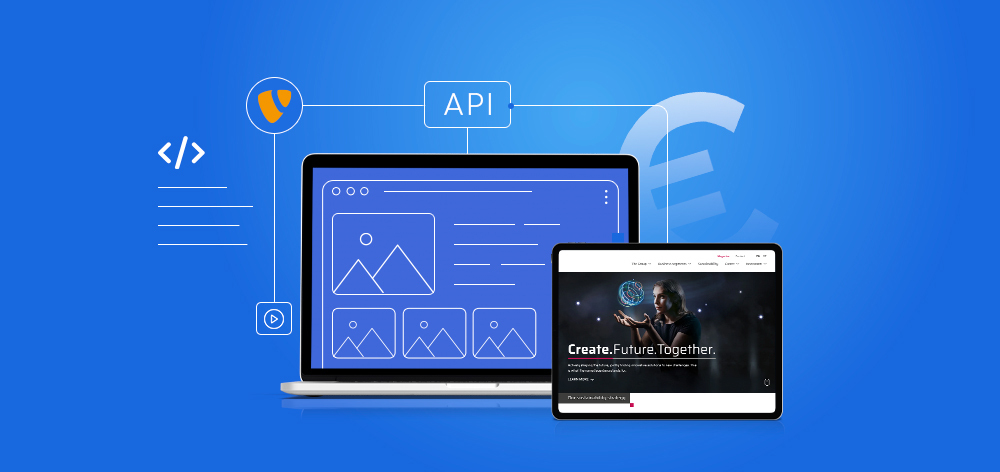
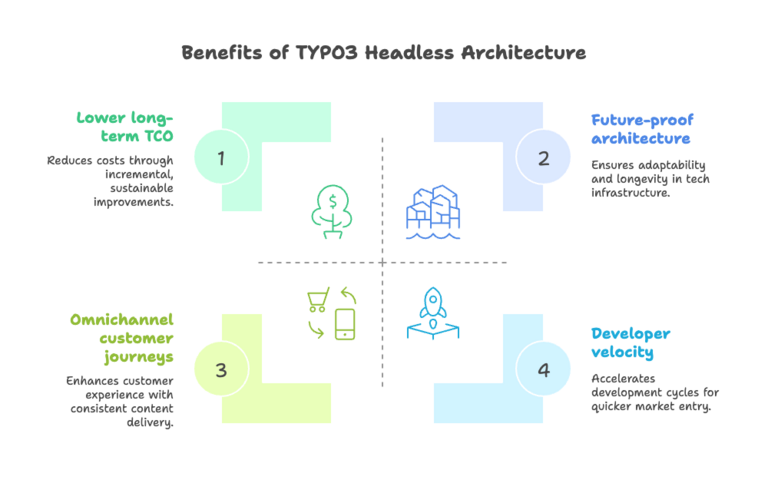
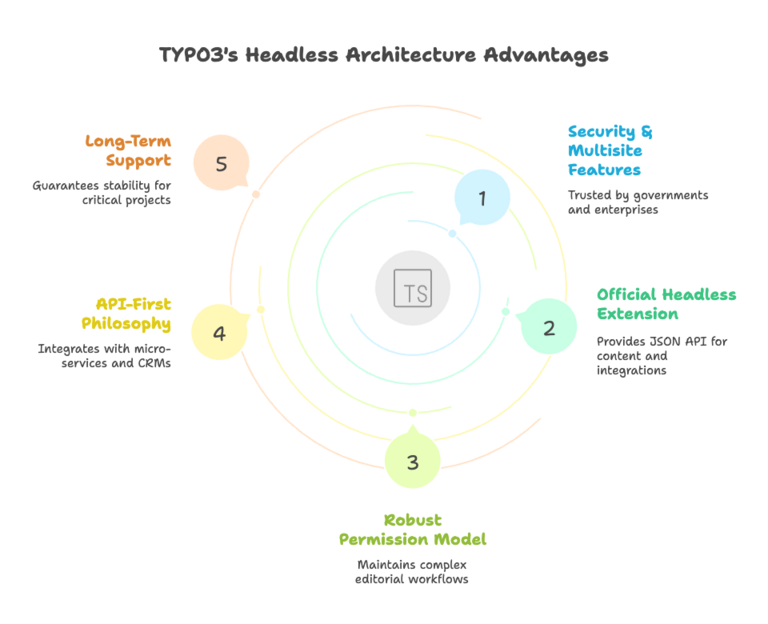
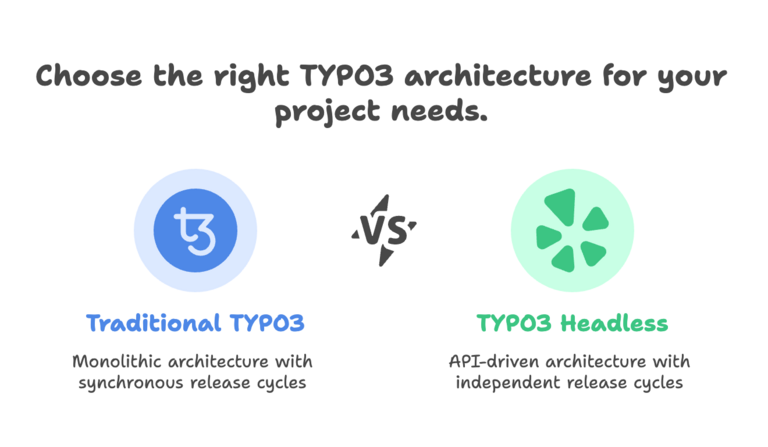
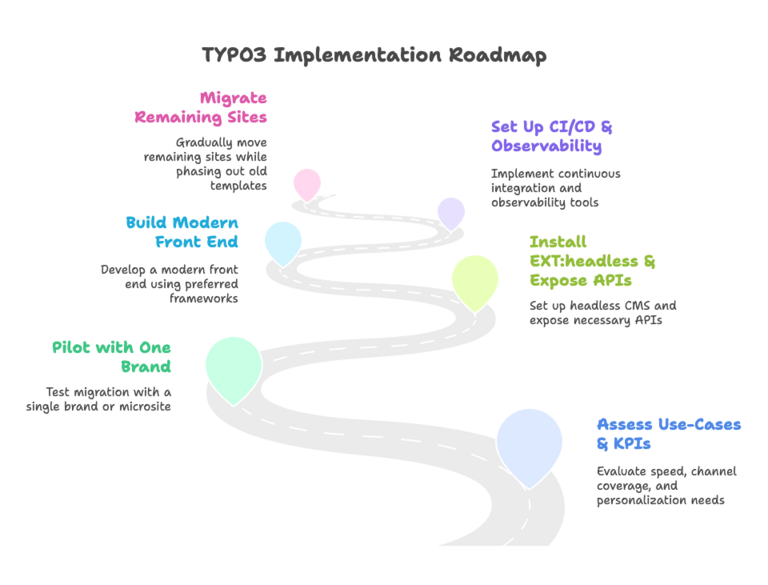



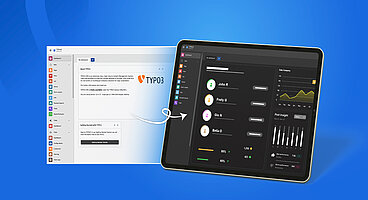
Wolfgang Weber
Brand & Communication LeadWolfgang Weber gestaltet TYPO3 mit Leidenschaft und Expertise. Als langjähriger TYPO3-Enthusiast hat er zu zahlreichen Projekten beigetragen, die Websites schneller und sicherer machen. Abseits von TYPO3 findet man ihn…
More From Author